Encapsulation of Polyphenolic Preparation in Gelatin Fruit Jellies Slows the Digestive Release of Cholinesterase Inhibitors In Vitro
Abstract
:1. Introduction
2. Materials and Methods
2.1. Materials
2.2. Producion of Polyphenolic Preparation (PP)
2.3. Dry Mass
2.4. Total Phenolic Content (TPC)
2.5. Total Flavonoid Content (TFvC)
2.6. Total Flavanol Content (TFnC)
2.7. Total Condensed Tannins (TCT)
2.8. Total Anthocyanin ContenT (TAC)
2.9. Qualitative and Quantitative LC-MS (HPLC-HRMS and HRMS/MS)
2.10. Selecting of the Final Gelling Agent
2.11. Final Jelly Recipe
2.12. Consumer Evaluation of the Jellies—A Pilot Study
2.13. In Vitro Digestion
2.14. In Vitro Biological Activities
2.14.1. Effect on Acetyl- and Butyrylcholinesterase (Anti-AChE and Anti-BChE Activity)
2.14.2. Effect on Cyclooxygenase-2 (COX-2) Activity
2.14.3. Effect on Catalase (CAT) Activity
2.14.4. Effect on Superoxide Dismutase (SOD) Activity
2.14.5. Effect on Glutathione Peroxidase (GPx) and Glutathione Reductase (GR) Activity
2.14.6. Ferric Reducing Antioxidant Power (FRAP)
2.14.7. Cupric Reducing Antioxidant Capacity (CUPRAC)
2.14.8. Hydroxyl Radical Antioxidant Capacity (HORAC)
2.14.9. Linoleic Acid Oxidation Test
2.14.10. Beta-Carotene Bleaching Test
2.14.11. Antiradical Activity (ABTS*+)
2.14.12. Antiradical Activity (DPPH)
2.15. Statistical Analysis
3. Results
3.1. In Vitro Biological Activities of Inividual Ultrafiltrates and PP
3.2. Consumer Analysis of Jellies
3.3. Changes in the Content of Polyphenolic Compounds in PP and PP-Enriched Jellies During In Vitro Digestion
4. Discussion
5. Conclusions
Supplementary Materials
Author Contributions
Funding
Institutional Review Board Statement
Informed Consent Statement
Data Availability Statement
Acknowledgments
Conflicts of Interest
References
- Norouzkhani, N.; Afshari, S.; Sadatmadani, S.F.; Mollaqasem, M.M.; Mosadeghi, S.; Ghadri, H.; Fazlizade, S.; Alizadeh, K.; Javar, P.A.; Amiri, H.; et al. Therapeutic potential of berries in age-related neurological disorders. Front. Pharmacol. 2024, 15, 1348127. [Google Scholar] [CrossRef]
- Cheng, N.; Bell, L.; Lamport, D.J.; Williams, C.M. Dietary flavonoids and human cognition: A meta-analysis. Mol. Nutr. Food Res. 2022, 66, 2100976. [Google Scholar] [CrossRef] [PubMed]
- Witkowska, A.M.; Zujko, M.E.; Waśkiewicz, A.; Terlikowska, K.M.; Piotrowski, W. Comparison of various databases for estimation of dietary polyphenol intake in the population of Polish adults. Nutrients 2025, 7, 9299–9308. [Google Scholar] [CrossRef] [PubMed]
- Huang, Q.; Braffett, B.H.; Simmens, S.J.; Young, H.A.; Ogden, C.L. Dietary polyphenol intake in US adults and 10-year trends: 2007–2016. J. Acad. Nutr. Diet. 2020, 120, 1821–1833. [Google Scholar] [CrossRef] [PubMed]
- Perez-Jimenez, J.; Fezeu, L.; Touvier, M.; Arnault, N.; Manach, C.; Hercberg, S.; Galan, P.; Scalbert, A. Dietary intake of 337 polyphenols in French adults. Am. J. Clin. Nutr. 2011, 93, 1220–1228. [Google Scholar] [CrossRef]
- Ziauddeen, N.; Rosi, A.; Del Rio, D.; Amoutzopoulos, B.; Nicholson, S.; Page, P.; Scazzina, F.; Brighenti, F.; Ray, S.; Mena, P. Dietary intake of (poly) phenols in children and adults: Cross-sectional analysis of UK National Diet and Nutrition Survey Rolling Programme (2008–2014). Eur. J. Nutr. 2019, 58, 3183–3198. [Google Scholar] [CrossRef]
- Locateli, G.; Peralta, R.M.; Koehnlein, E.A. Recommended consumption of fruits and vegetables increases the intake of polyphenols and flavonoids in Brazilian adults. Curr. Nutr. Food Sci. 2020, 16, 314–322. [Google Scholar] [CrossRef]
- Bešlo, D.; Golubić, N.; Rastija, V.; Agić, D.; Karnaš, M.; Šubarić, D.; Lučić, B. Antioxidant activity, metabolism, and bioavailability of polyphenols in the diet of animals. Antioxidants 2023, 12, 1141. [Google Scholar] [CrossRef]
- Pandey, K.B.; Rizvi, S.I. Plant polyphenols as dietary antioxidants in human health and disease. Oxidative Med. Cell. Longev. 2009, 2, 270–278. [Google Scholar] [CrossRef]
- Szwajgier, D.; Paduch, R.; Kukuła-Koch, W.; Polak-Berecka, M.; Waśko, A. Study on biological activity of bread enriched with natural polyphenols in terms of growth inhibition of tumor intestine cells. J. Med. Food. 2020, 23, 181–190. [Google Scholar] [CrossRef]
- Gajowniczek-Ałasa, D.; Baranowska-Wójcik, E.; Szwajgier, D. Changes in anticholinesterase and antioxidant activities of fruit products during storage. Appl. Sci. 2024, 14, 6187. [Google Scholar] [CrossRef]
- Narwojsz, A.; Borowska, E. Changes in structure-forming components of blackcurrant fruits during mash maceration and release of polyphenols into juice. Żywność Nauka Technol. Jakość 2011, 18, 87–98. [Google Scholar]
- Studzińska-Sroka, E.; Majchrzak-Celińska, A.; Zalewski, P.; Szwajgier, D.; Baranowska-Wójcik, E.; Kaproń, B.; Plech, T.; Żarowski, M.; Cielecka-Piontek, J. Lichen-derived compounds and extracts as biologically active substances with anticancer and neuroprotective properties. Pharmaceuticals 2021, 14, 1293. [Google Scholar] [CrossRef] [PubMed]
- Szwajgier, D.; Baranowska-Wójcik, E.; Kukula-Koch, W.; Kowalik, K.; Polak-Berecka, M.; Waśko, A. Evolution of the anticholinesterase, antioxidant, and anti-inflammatory activity of Epilobium angustifolium L. infusion during in vitro digestion. J. Funct. Foods 2021, 85, 104645. [Google Scholar] [CrossRef]
- Gustaw, W.; Mleko, S. The effect of pH and carrageenan concentration on the rheological properties of whey protein gels. Pol. J. Food Nutr. Sci. 2023, 12, 39–44. [Google Scholar]
- Baryłko-Pikielna, N.; Matuszewska, I. Sensoryczne Badania Żywności: Podstawy, Metody, Zastosowania; Wyd. Nauk. PTTŻ: Warsaw, Poland, 2014. [Google Scholar]
- Cebi, N.; Dogan, C.E.; Mese, A.E.; Ozdemir, D.; Arıcı, M.; Sagdic, O. A rapid ATR-FTIR spectroscopic method for classification of gelatin gummy candies in relation to the gelatin source. Food Chem. 2019, 277, 373–381. [Google Scholar] [CrossRef]
- de Moura, S.C.; Berling, C.L.; Garcia, A.O.; Queiroz, M.B.; Alvim, I.D.; Hubinger, M.D. Release of anthocyanins from the hibiscus extract encapsulated by ionic gelation and application of microparticles in jelly candy. Food Res. Int. 2019, 121, 542–552. [Google Scholar] [CrossRef]
- Naresh, K.; Varakumar, S.; Variyar, P.S.; Sharma, A.; Reddy, O.V.S. Enhancing antioxidant activity, microbial and sensory quality of mango (Mangifera indica L.) juice by γ-irradiation and its in vitro radioprotective potential. J. Food Sci. Technol. 2015, 52, 4054–4065. [Google Scholar] [CrossRef]
- Gacula, M.C., Jr. Design and Analysis of Sensory Optimization; Wiley-Blackwell: Hoboken, NJ, USA, 2008; ISBN 978-0-470-38479-4. [Google Scholar]
- Meilgaard, M.; Civille, G.V.; Carr, B.T. Sensory Evaluation Techniques, 4th ed.; CRC Press: Boca Raton, FL, USA, 2007; p. 448. [Google Scholar]
- Saint-Eve, A.; Déléris, I.; Panouillé, M.; Dakowski, F.; Cordelle, S.; Schlich, P.; Souchon, I. How texture influences aroma and taste perception over time in candies. Chemosens. Percept. 2011, 4, 32–41. [Google Scholar] [CrossRef]
- Jangchud, K.; Jangchud, A.; Prinyawiwatkul, W. Soft starchy candy as a food model to study the relationship between sensory and selected physicochemical properties. Int. J. Food Sci. Technol. 2013, 48, 2078–2085. [Google Scholar] [CrossRef]
- Hani, N.M.; Romli, S.R.; Ahmad, M. Influences of red pitaya fruit puree and gelling agents on the physico-mechanical properties and quality changes of gummy confections. Int. J. Food Sci. Technol. 2015, 50, 331–339. [Google Scholar] [CrossRef]
- Lans, A.M.; Frelka, J.C.; Paluri, S.; Vodovotz, Y. Physical properties and sensory analysis of galacto-oligosaccharide glassy confections. LWT 2018, 96, 499–506. [Google Scholar] [CrossRef]
- Baranowska-Wójcik, E.; Szwajgier, D.; Gustaw, K.; Jośko, I.; Pawlikowska-Pawlęga, B.; Kapral-Piotrowska, J. Reduced bioaccessibility of TiO2 (E 171) during puree soup digestion in a gastrointestinal tract simulated in vitro. Food Res. Int. 2023, 164, 112189. [Google Scholar] [CrossRef]
- Stewart, R.J.; Morton, H.; Coad, J.; Pedley, K.C. In vitro digestion for assessing micronutrient bioavailability: The importance of digestion duration. Int. J. Food Sci. Nutr. 2019, 70, 71–77. [Google Scholar] [CrossRef] [PubMed]
- Watanabe, M.; de Moura Neiva, L.B.; da Costa Santos, C.X.; Laurindo, F.R.M.; Vattimo, M.D.F.F. Isoflavone and the heme oxygenase system in ischemic acute kidney injury in rats. Food Chem. Toxicol. 2007, 45, 2366–2371. [Google Scholar] [CrossRef]
- Gürer, E.S.; Yıldırım, Ş.; Kocyigit, Ü.M.; Berisha, A.; Kaya, S. Experimental, density functional theory, molecular docking and ADMET analyses on the role of different plant extracts of Aronia melanocarpa (Michx) Elliot species on acetylcholinesterase enzyme activity. J. Mol. Struc. 2025, 1321, 139893. [Google Scholar] [CrossRef]
- Tomer, V.; Chhikara, N.; Kumar, A.; Panghal, A. (Eds.) Nutraceuticals from Fruit and Vegetable Waste; John Wiley & Sons: Hoboken, NJ, USA, 2024; ISBN 9781119803508. [Google Scholar]
- Yamane, T.; Imai, M.; Handa, S.; Ihara, H.; Sakamoto, T.; Ishida, T.; Nakagaki, T.; Uchiyama, S. Aronia juice improves working memory and suppresses δ-secretase activity in 5XFAD mice. NFS J. 2023, 32, 100146. [Google Scholar] [CrossRef]
- Balawejder, M.; Piechowiak, T.; Kapusta, I.; Chęciek, A.; Matłok, N. In vitro analysis of selected antioxidant and biological properties of the extract from large-fruited cranberry fruits. Molecules 2023, 28, 7895. [Google Scholar] [CrossRef]
- Yadav, P.; Panda, S.P.; Soni, R.; Kumari, M.; Pathak, L.; Jha, S. Natural O-6-methylguanine-DNA methyl transferase (MGMT) gene antagonist from Vaccinium oxycoccus: A new hope in Alzheimer’s therapeutics. Chem. Biol. Lett. 2023, 10, 549. [Google Scholar]
- Nowicka, P.; Wojdyło, A.; Tkacz, K.; Turkiewicz, I.P. Quantitative and qualitative determination of carotenoids and polyphenolics compounds in selected cultivars of Prunus persica L. and their ability to in vitro inhibit lipoxygenase, cholinoesterase, α-amylase, α-glucosidase and pancreatic lipase. Food Chem. X 2023, 17, 100619. [Google Scholar] [CrossRef]
- Szwajgier, D.; Borowiec, K.; Zapp, J. Activity-guided isolation of cholinesterase inhibitors quercetin, rutin and kaempferol from Prunus persica fruit. Z. Naturforsch. C 2020, 75, 87–96. [Google Scholar] [CrossRef] [PubMed]
- Suresh, S.; Begum, R.F.; Singh, A.; Chitra, V. Anthocyanin as a therapeutic in Alzheimer’s disease: A systematic review of preclinical evidences. Ageing Res. Rev. 2022, 76, 101595. [Google Scholar] [CrossRef] [PubMed]
- Gómez-Mascaraque, L.G.; Soler, C.; Lopez-Rubio, A. Stability and bioaccessibility of EGCG within edible micro-hydrogels. Chitosan vs. gelatin, a comparative study. Food Hydrocol. 2016, 61, 128–138. [Google Scholar] [CrossRef]
- Peanparkdee, M.; Iwamoto, S.; Yamauchi, R. Preparation and release behavior of gelatin-based capsules of antioxidants from ethanolic extracts of Thai Riceberry bran. Food Bioprocess. Technol. 2017, 10, 1737–1748. [Google Scholar] [CrossRef]
- Peanparkdee, M.; Borompichaichartkul, C.; Iwamoto, S. Bioaccessibility and antioxidant activity of phenolic acids, flavonoids, and anthocyanins of encapsulated Thai rice bran extracts during in vitro gastrointestinal digestion. Food Chem. 2021, 361, 130161. [Google Scholar] [CrossRef]
- Dundar, A.N.; Uzuner, K.; Parlak, M.E.; Sahin, O.I.; Saricaoglu, F.T.; Simsek, S. Enhanced functionality and bioaccessibility of composite pomegranate peel extract-enriched “Boba Balls”. Foods 2022, 11, 3785. [Google Scholar] [CrossRef]
- Liu, L.; Zhang, D.; Song, X.; Guo, M.; Wang, Z.; Geng, F.; Zhou, X.; Nie, S. Compound hydrogels derived from gelatin and gellan gum regulates the release of anthocyanins in simulated digestion. Food Hydrocol. 2022, 127, 107487. [Google Scholar] [CrossRef]
- Silva, M.P.; Martelli-Tosi, M.; Massarioli, A.P.; Melo, P.S.; Alencar, S.M.; Favaro-Trindade, C.S. Co-encapsulation of guaraná extracts and probiotics increases probiotic survivability and simultaneously delivers bioactive compounds in simulated gastrointestinal fluids. LWT 2022, 161, 113351. [Google Scholar] [CrossRef]
- Martinović, J.; Lukinac, J.; Jukić, M.; Ambrus, R.; Planinić, M.; Šelo, G.; Klarić, A.-M.; Perković, G.; Bucić-Kojić, A. In vitro bioaccessibility assessment of phenolic compounds from encapsulated grape pomace extract by ionic gelation. Molecules 2023, 28, 5285. [Google Scholar] [CrossRef]
- Martinović, J.; Lukinac, J.; Jukić, M.; Ambrus, R.; Planinić, M.; Šelo, G.; Perković, G.; Bucić-Kojić, A. The release of grape pomace phenolics from alginate-based microbeads during simulated digestion in vitro: The influence of coatings and drying method. Gels 2023, 9, 870. [Google Scholar] [CrossRef]
- Moreira, F.D.; Reis, C.E.G.; Gallassi, A.D.; Moreira, D.C.; Welker, A.F. Suppression of the postprandial hyperglycemia in patients with type 2 diabetes by a raw medicinal herb powder is weakened when consumed in ordinary hard gelatin capsules: A randomized crossover clinical trial. PLoS ONE 2024, 19, e0311501. [Google Scholar]
- Ozcan, B.E.; Karakas, C.Y.; Karadag, A. Application of purple basil leaf anthocyanins-loaded alginate-carrageenan emulgel beads in gelatin-based jelly candies. Int. J. Biol. Macromol. 2024, 277, 134547. [Google Scholar] [CrossRef] [PubMed]
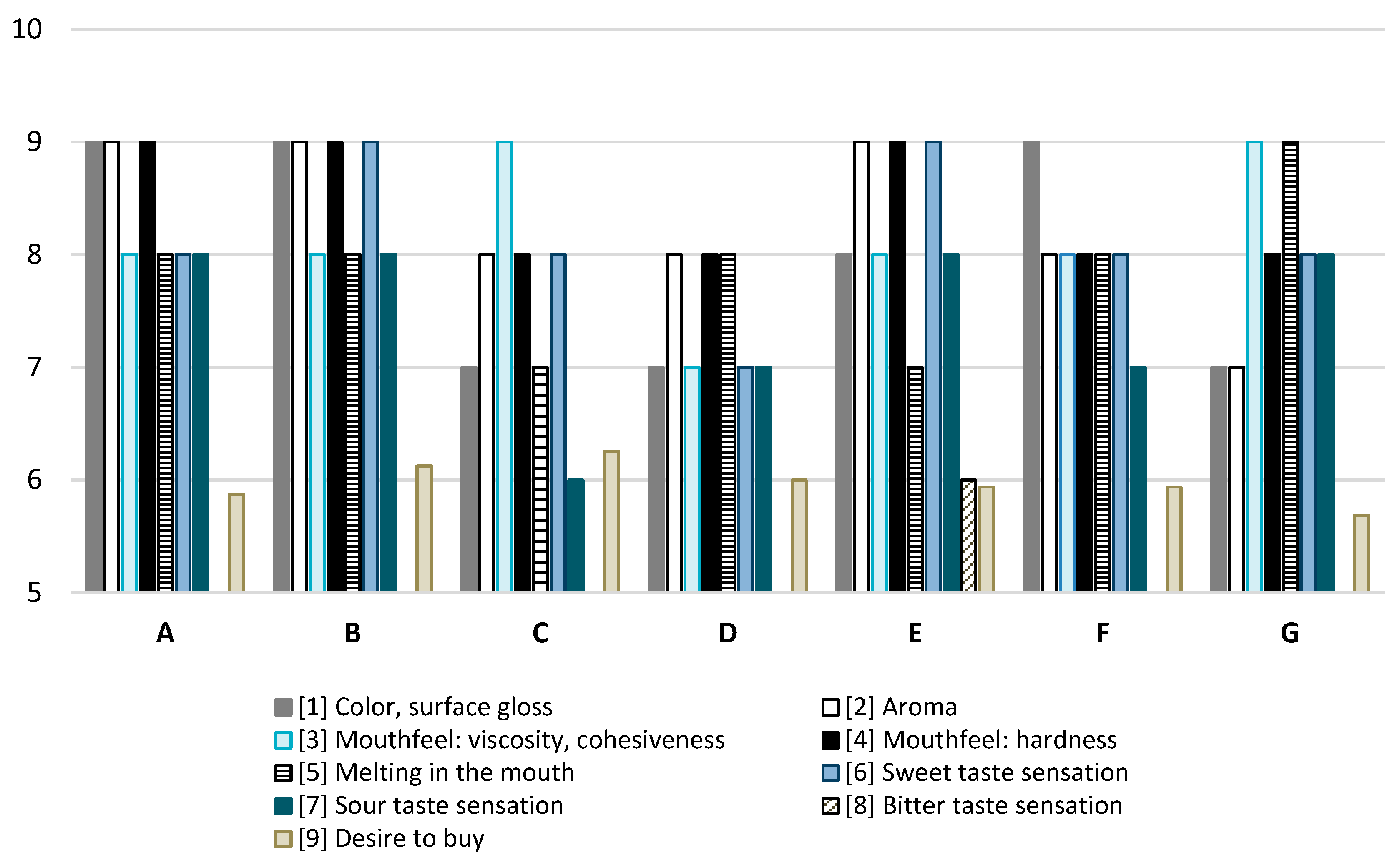
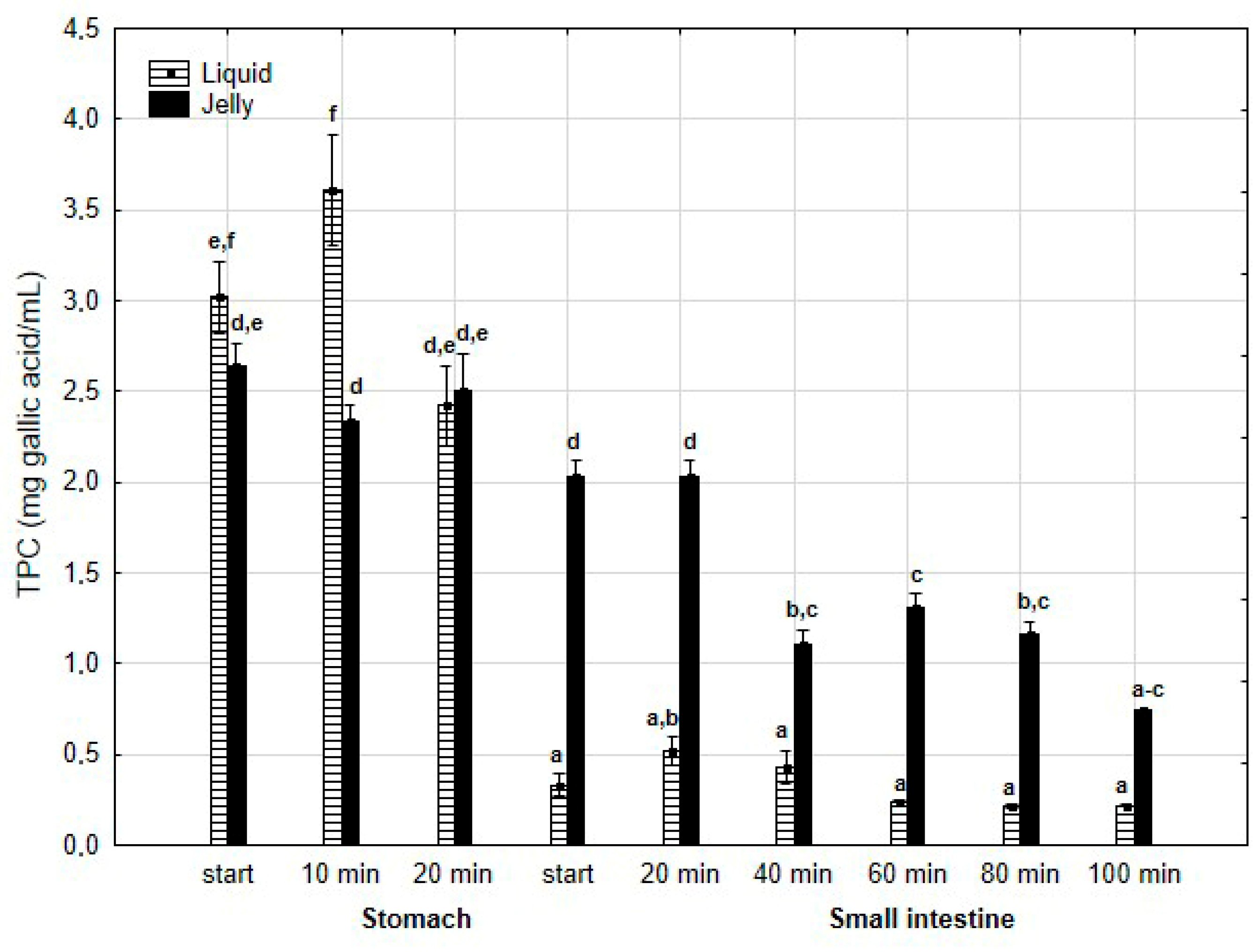
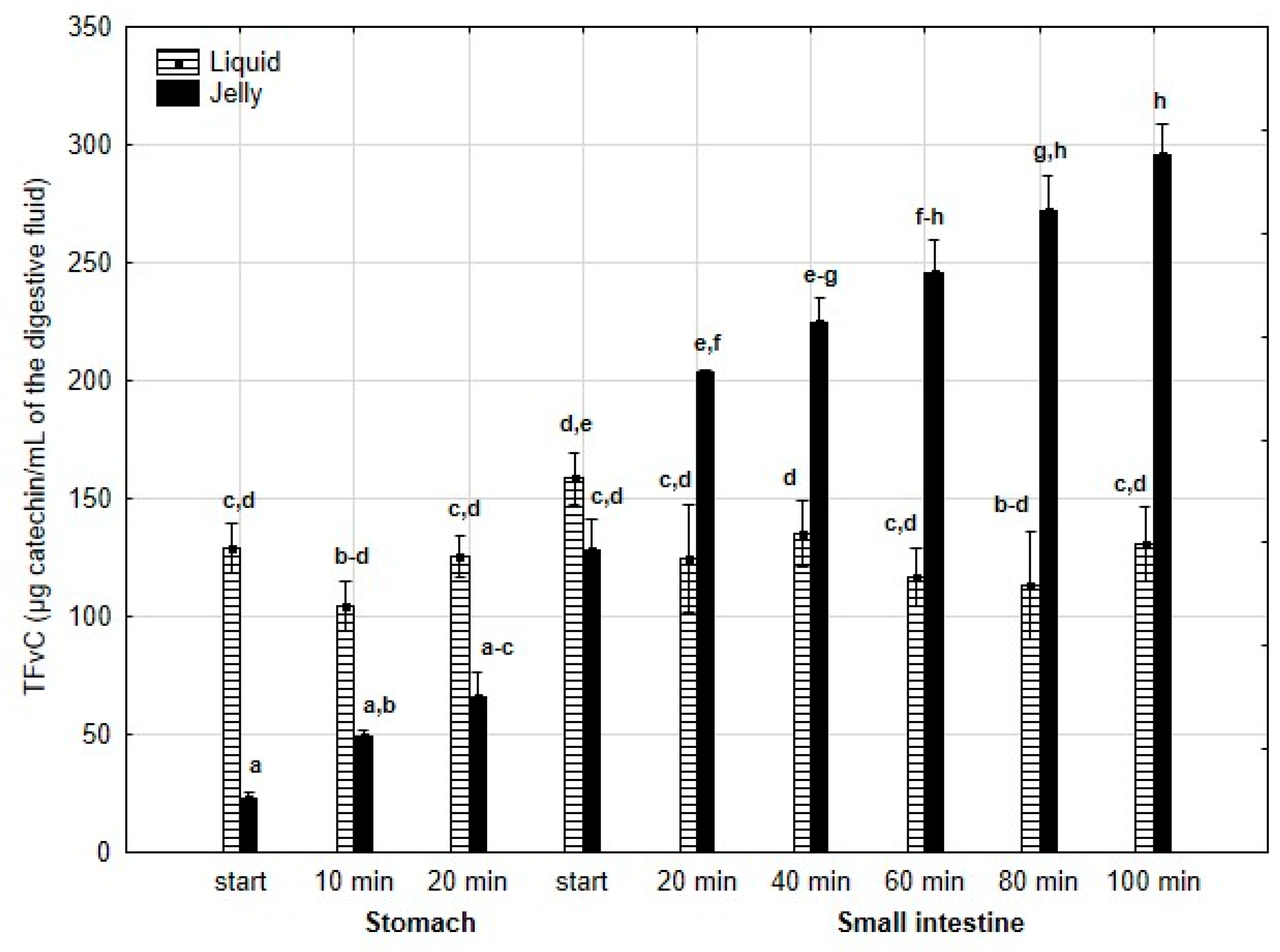
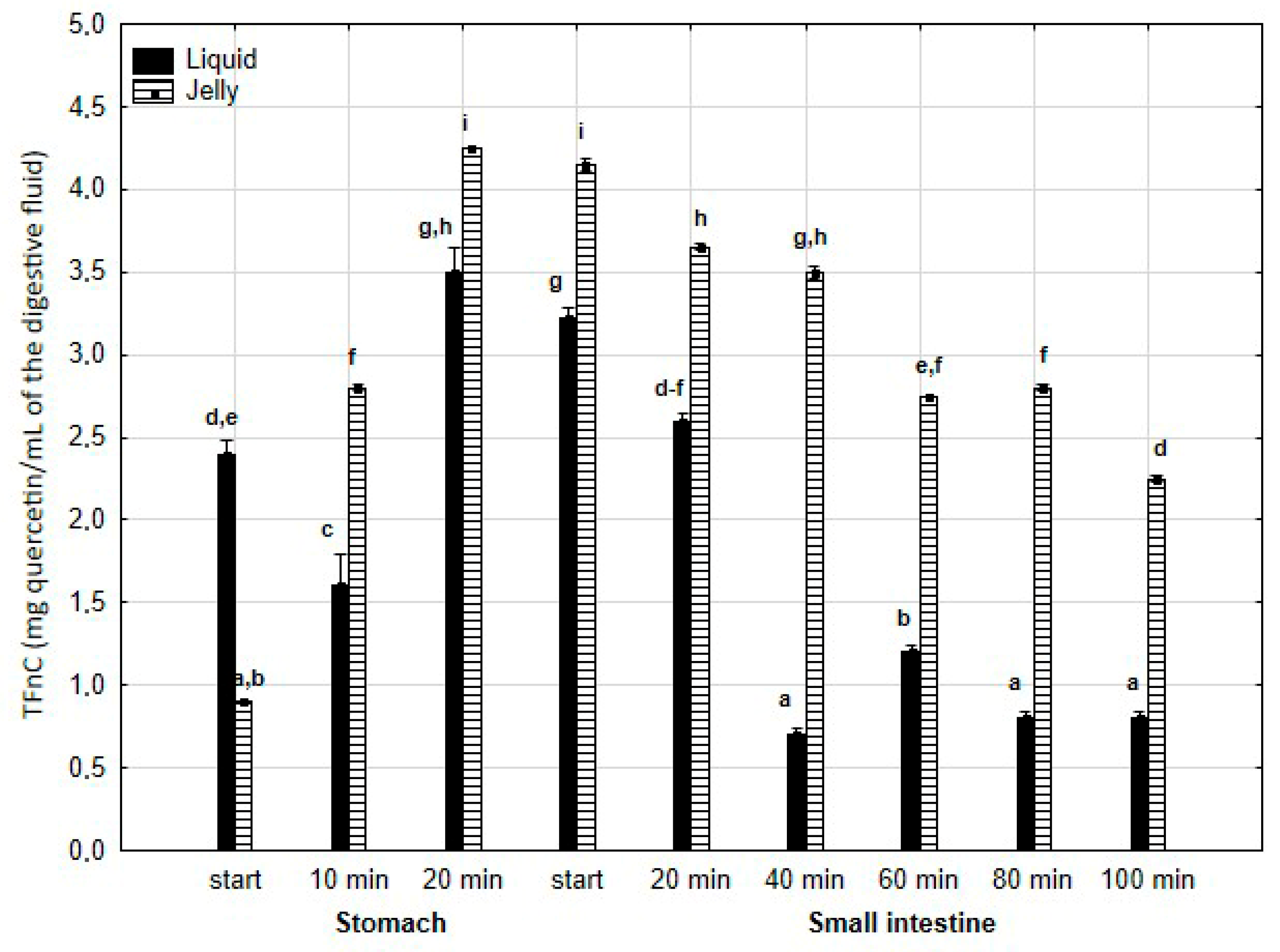
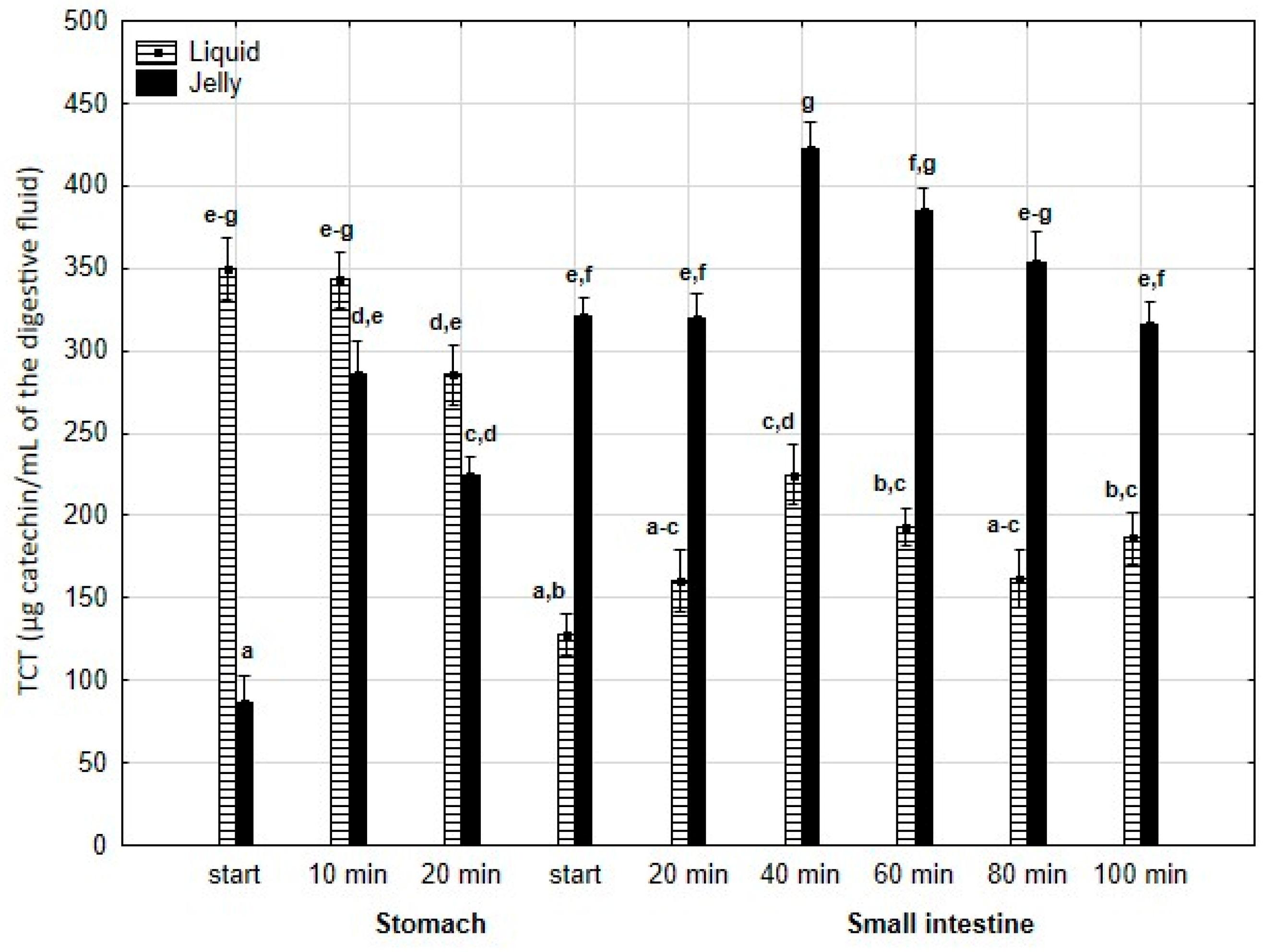
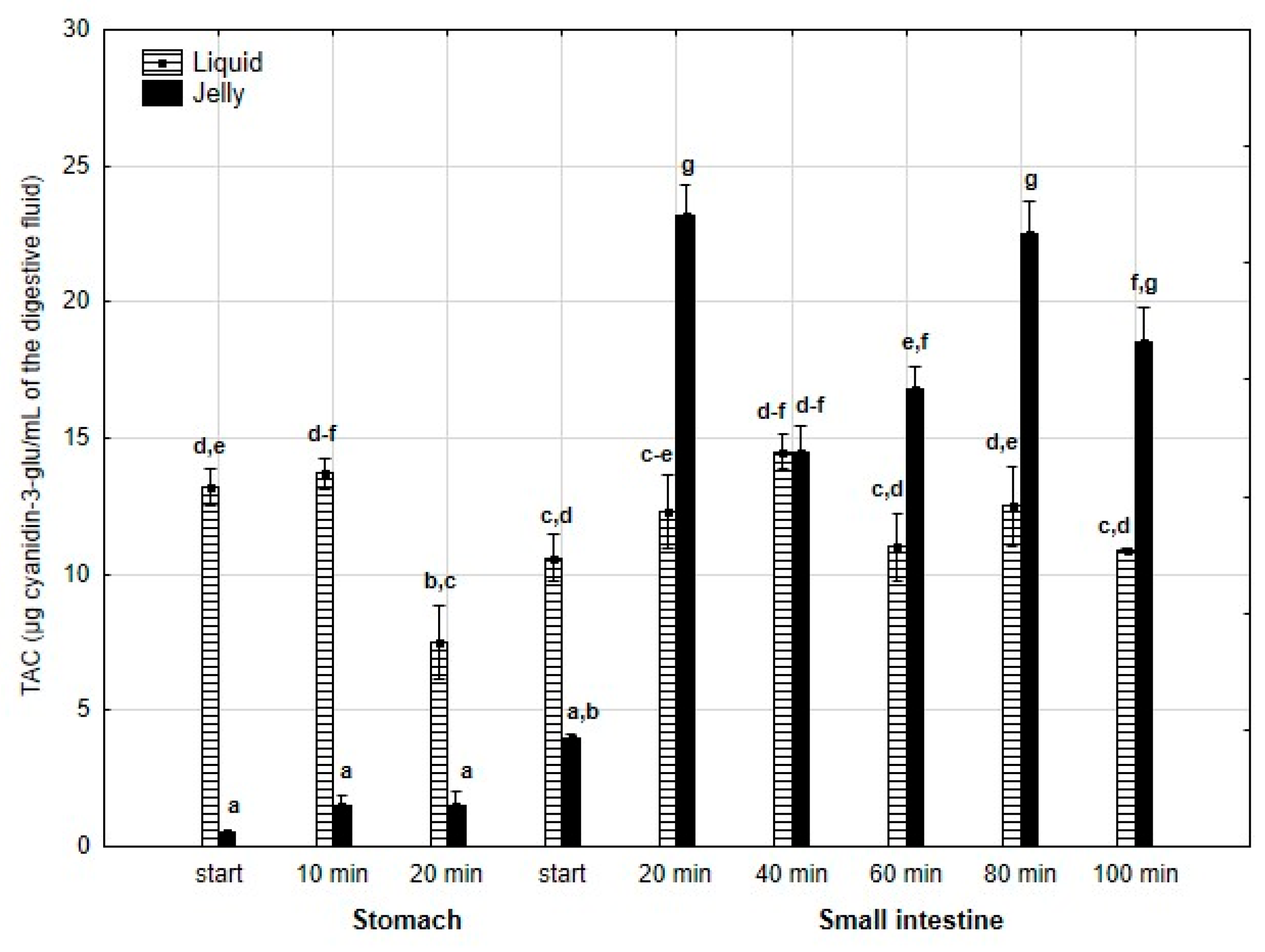
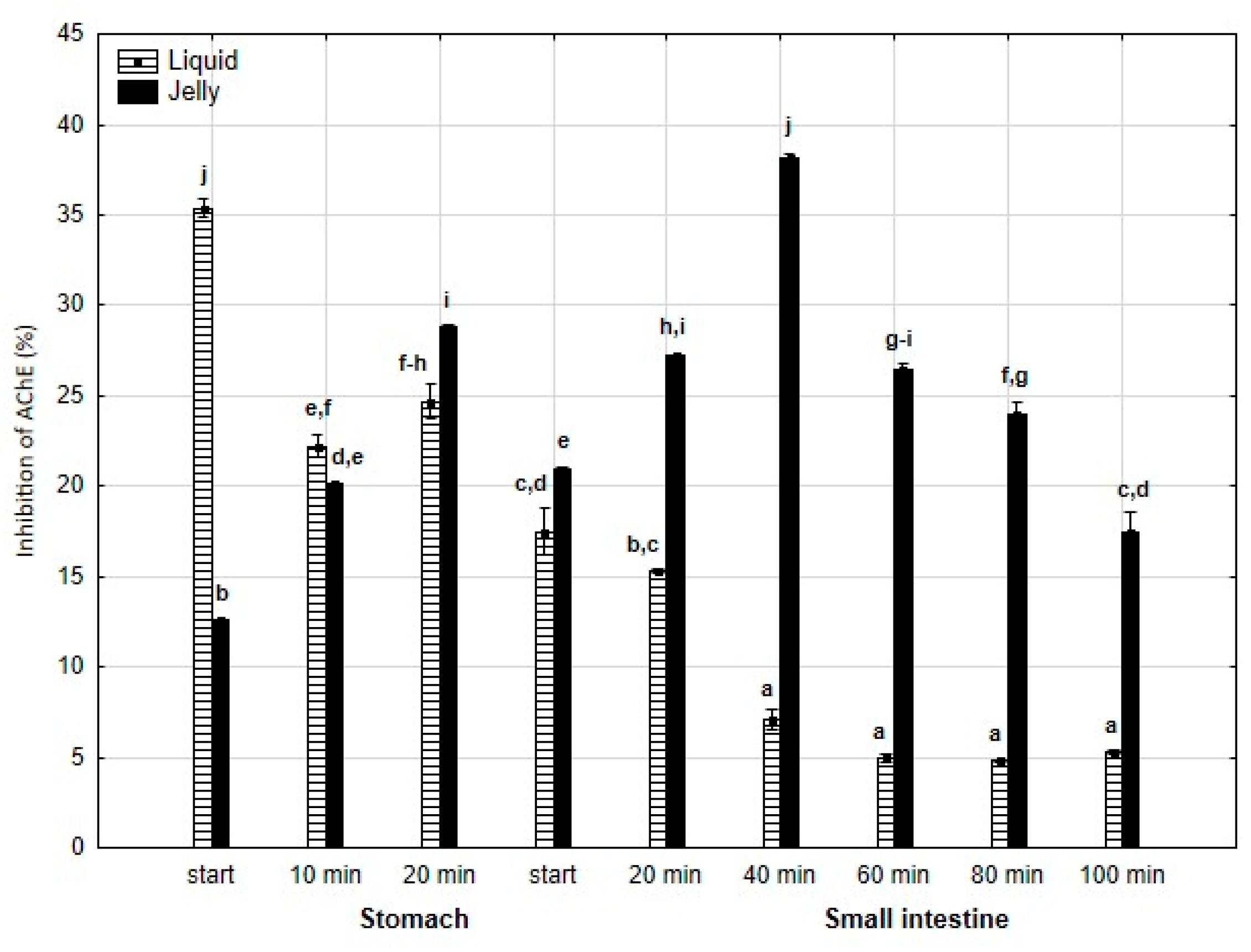
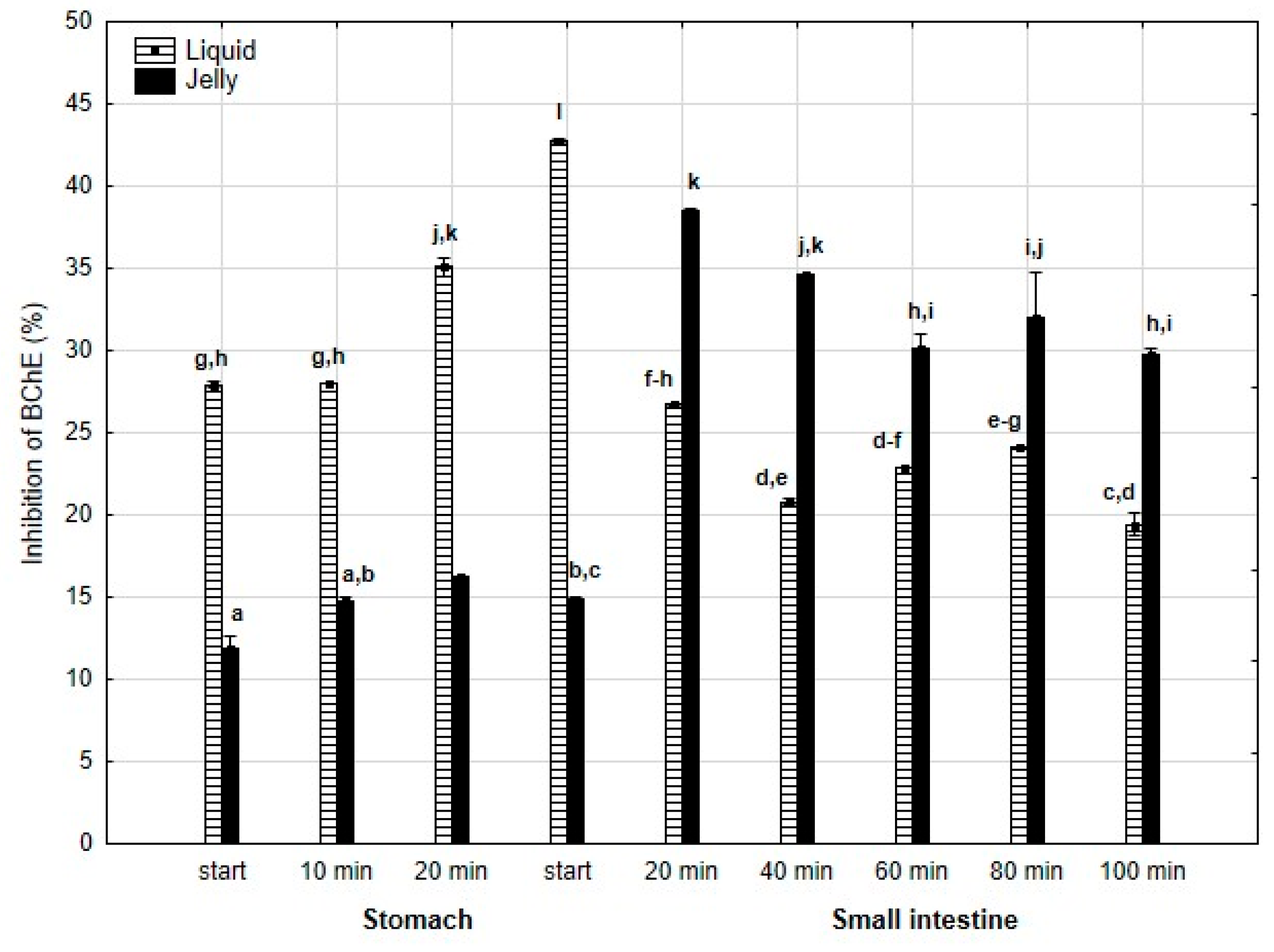
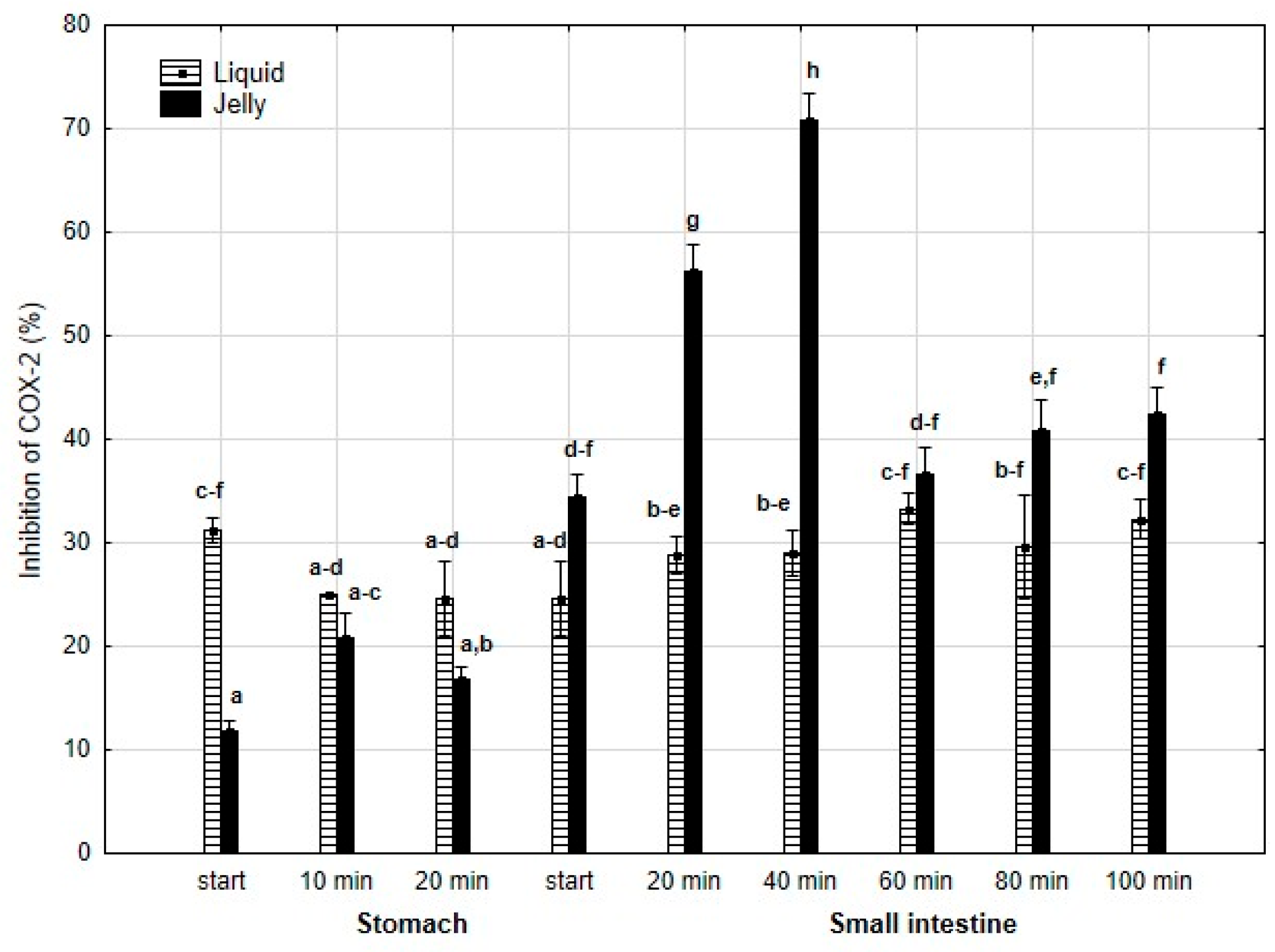
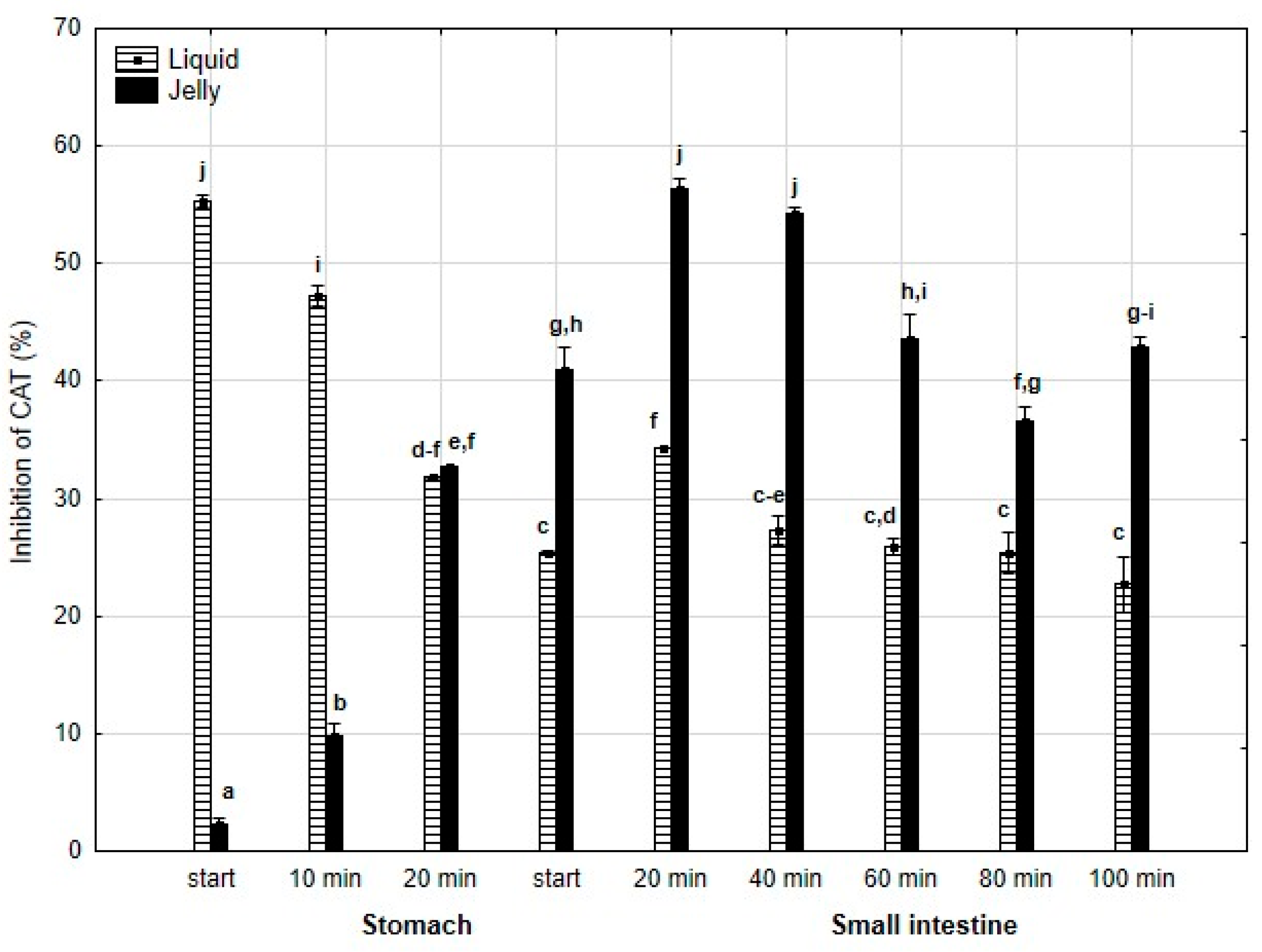
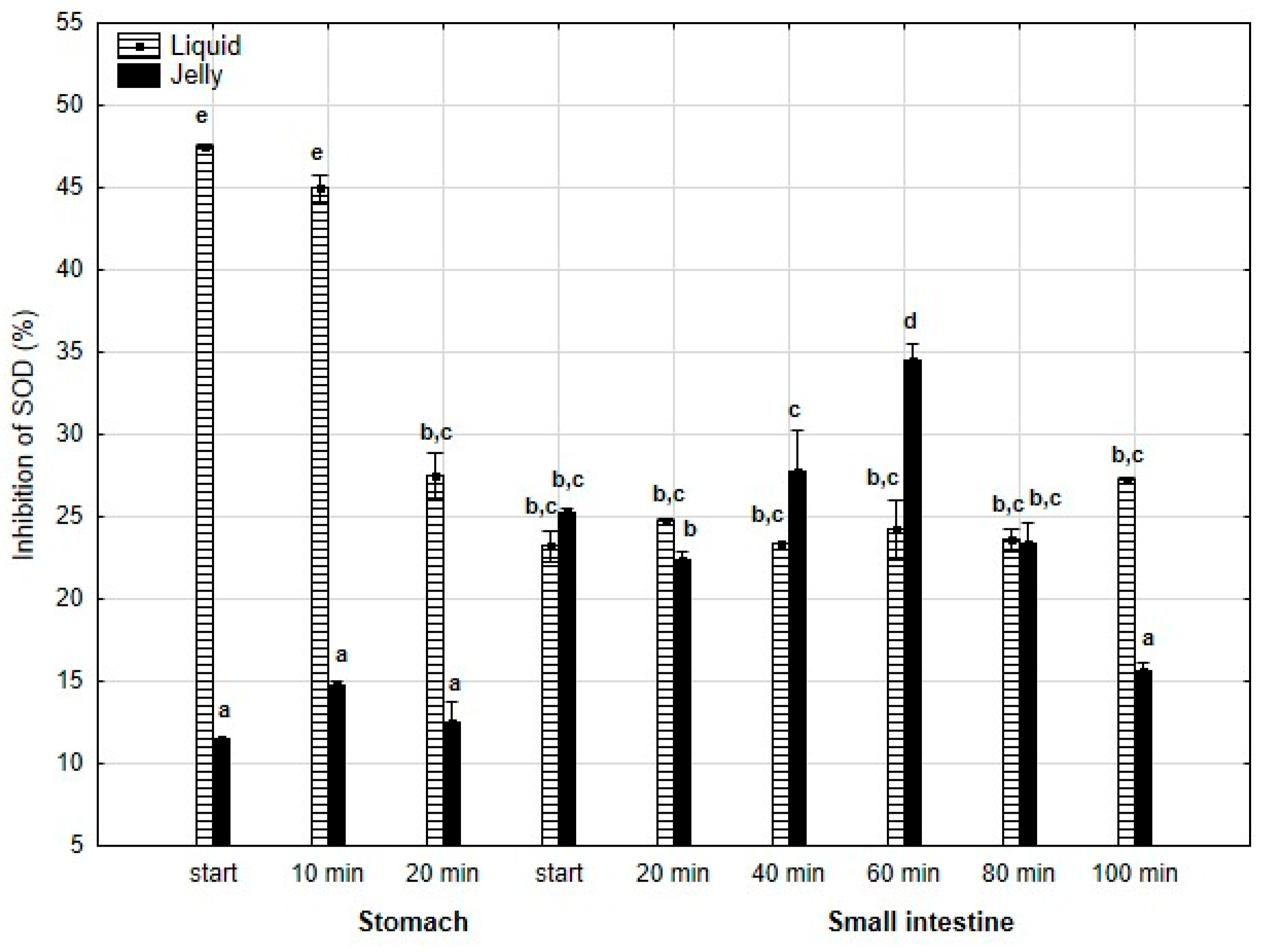
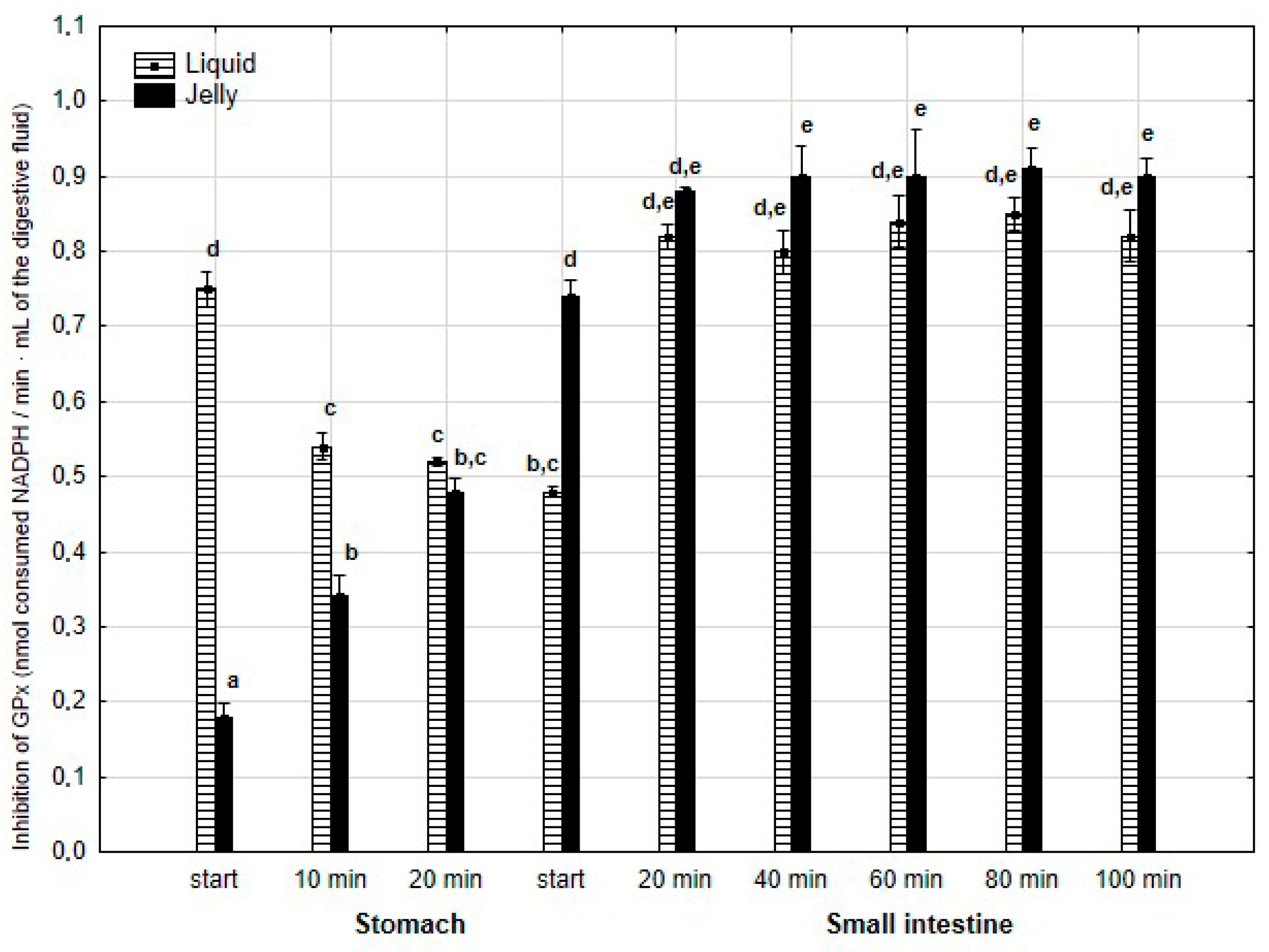

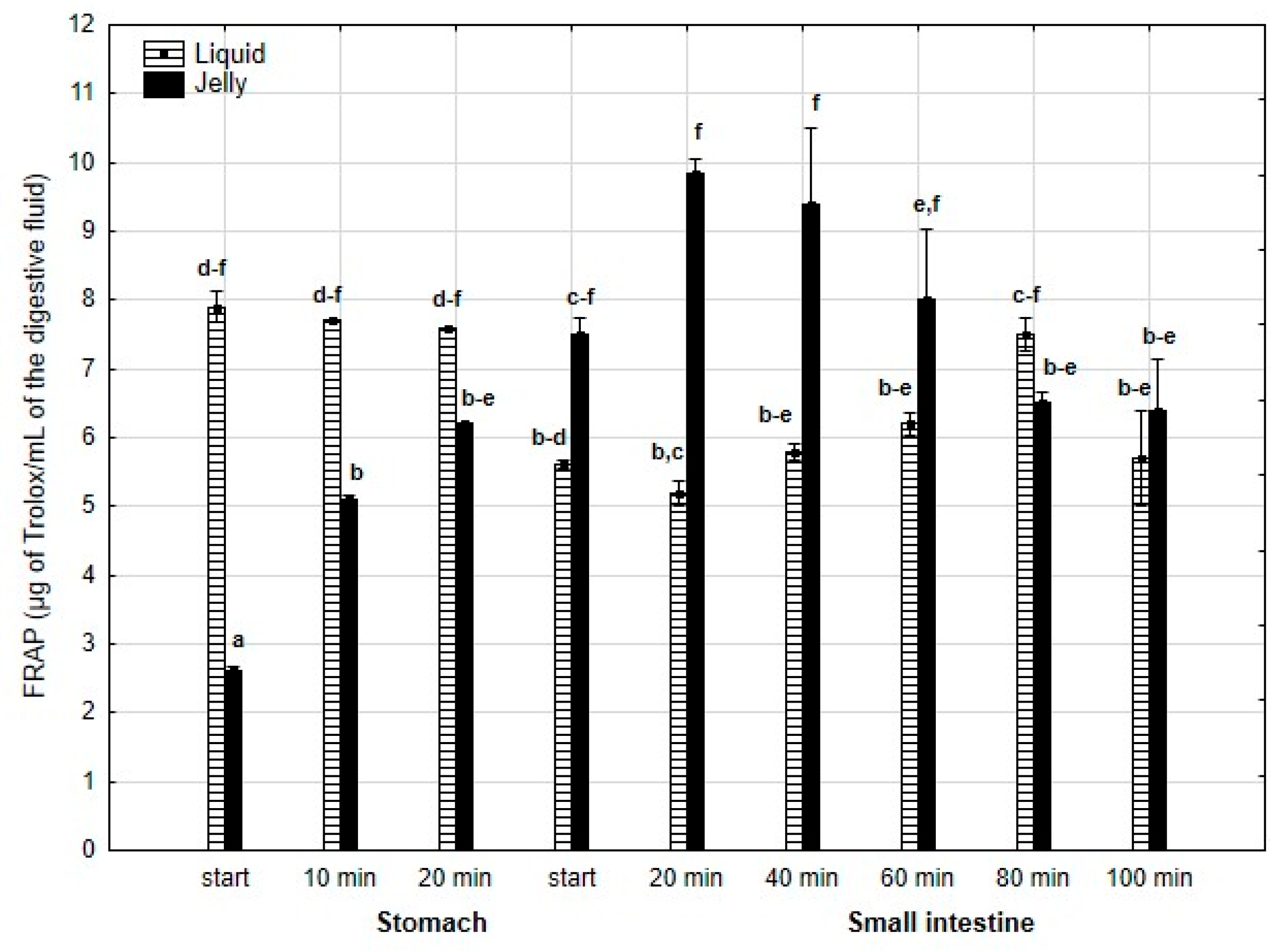
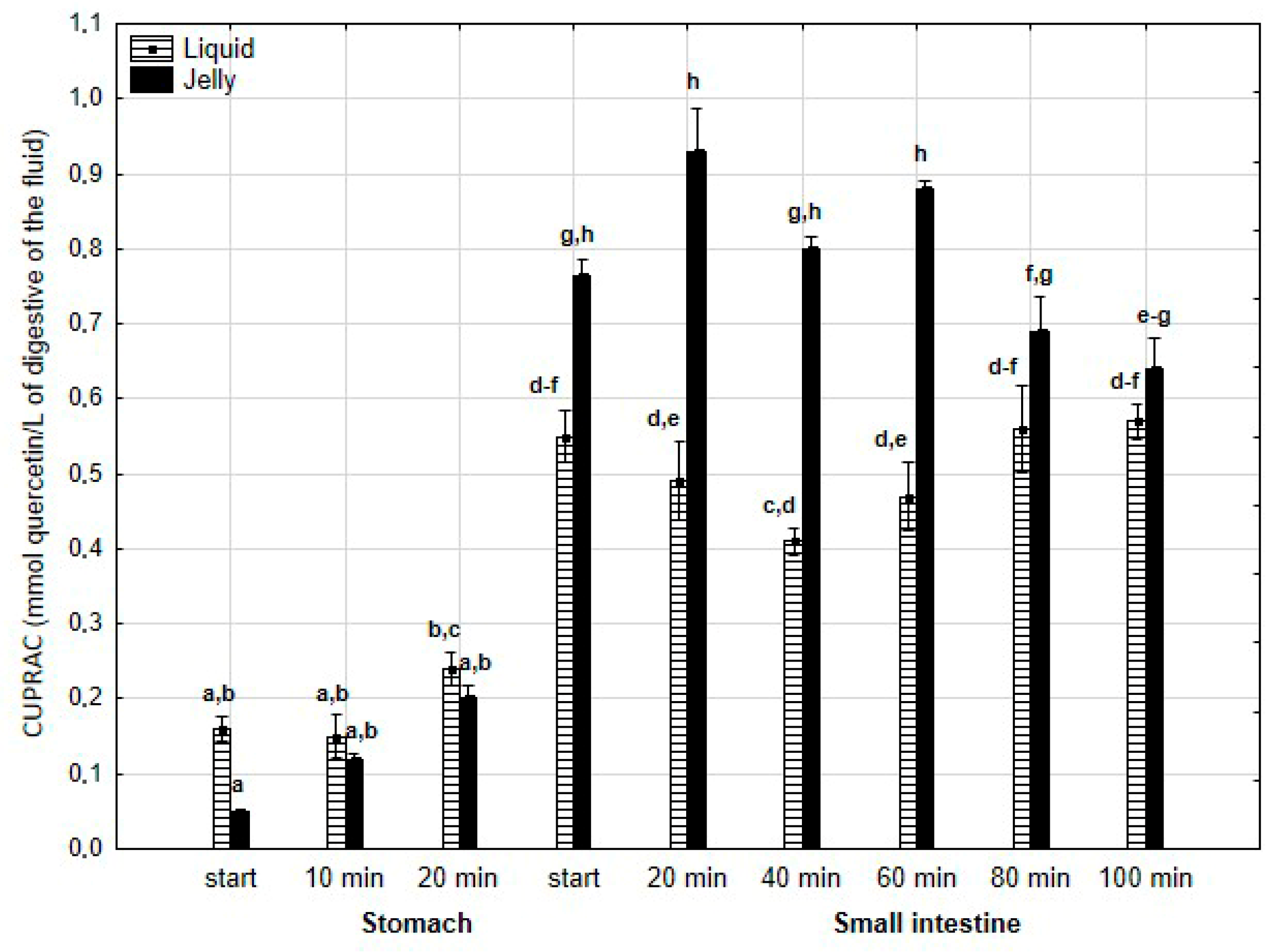
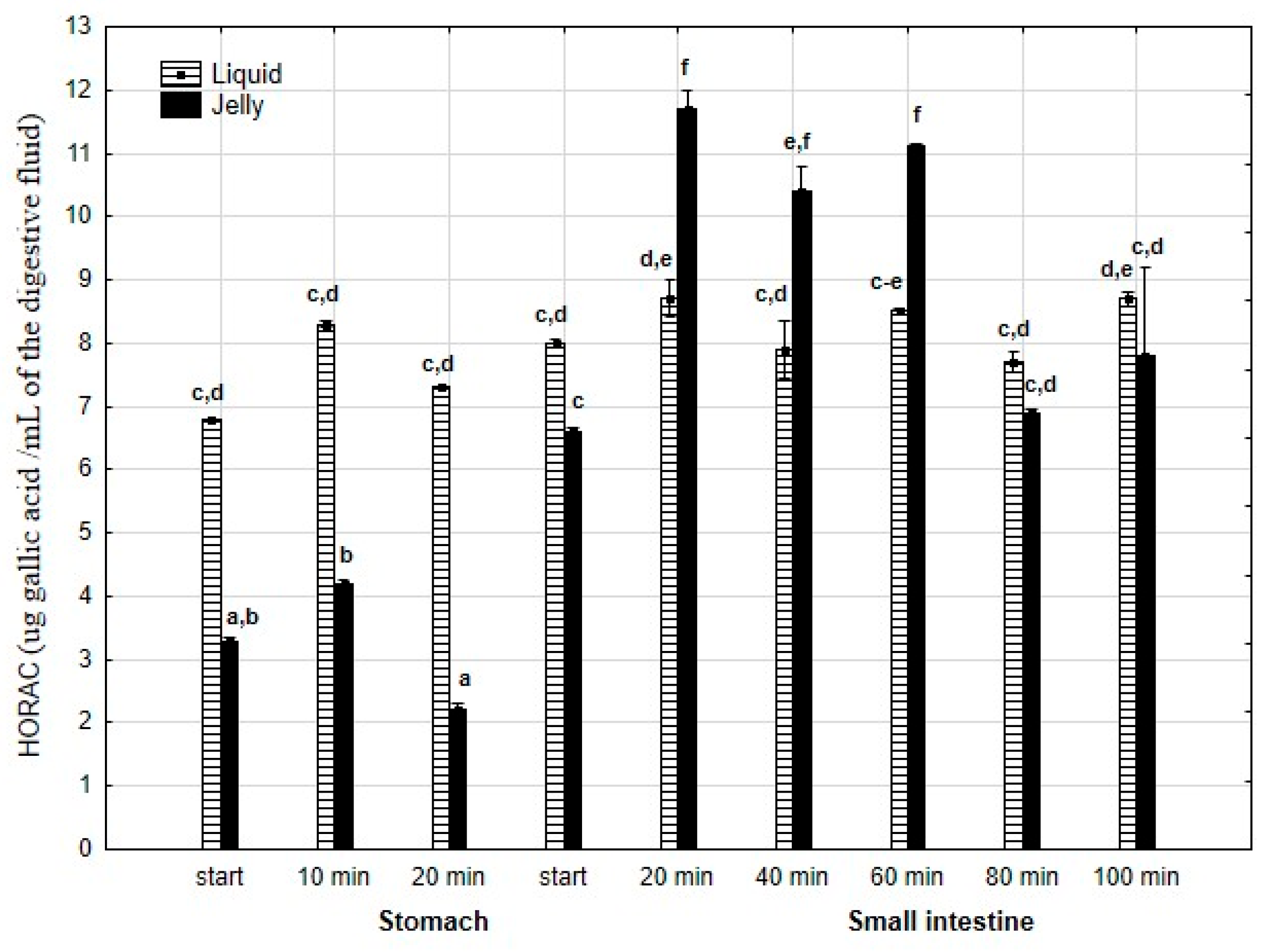


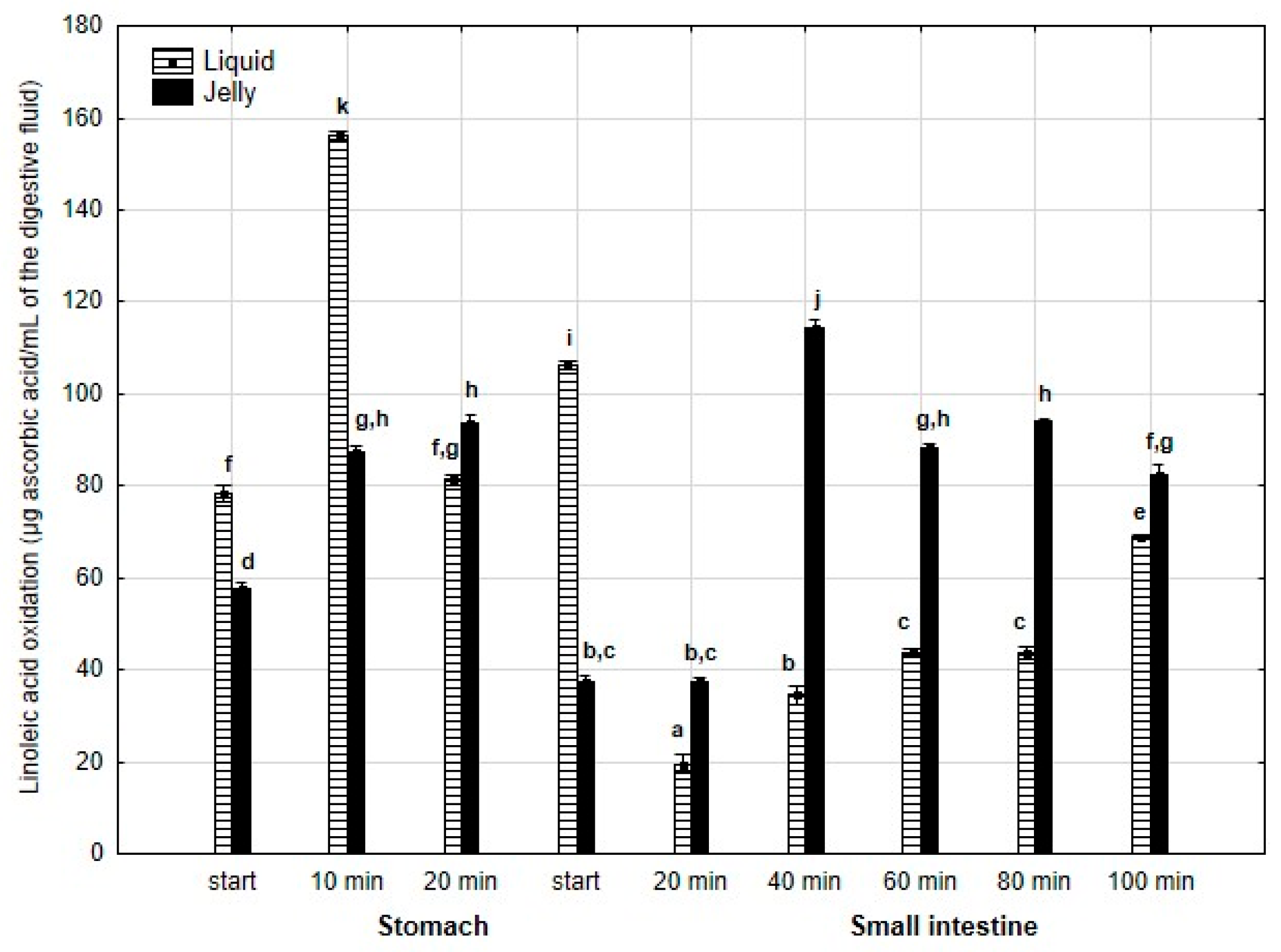

| Concentrated Ultrafiltrate From: | TPC (mg GAE/g) | TFvC (mg Quercetin/g) | TFnC (mg Catechin/g) | TCT (mg Catechin/g) | TAC (µg cya-3-glu/g) |
|---|---|---|---|---|---|
| Apricot | 6.11 ± 0.32 | 3.22 ± 0.01 | 0.03 ± 0.01 | 1.45 ± 0.08 | 3.07 ± 0.25 |
| Blueberry | 12.08 ± 0.41 | 3.56 ± 0.02 | 1.08 ± 0.01 | 4.62 ± 0.09 | 429.33 ± 1.03 |
| Chokeberry | 17.58 ± 0.48 | 7.00 ± 0.02 | 3.08 ± 0.01 | 4.94 ± 0.38 | 673.95 ± 1.98 |
| Cranberry | 13.11 ± 0.35 | 6.39 ± 0.03 | 2.04 ± 0.00 | 2.55 ± 0.16 | 42.35 ± 0.82 |
| Peach | 3.96 ± 0.11 | 1.34 ± 0.03 | 0.32 ± 0.01 | 1.23 ± 0.09 | 5.70 ± 0.36 |
| Raspberry | 8.79 ± 0.34 | 3.44 ± 0.01 | 0.27 ± 0.01 | 3.10 ± 0.10 | 158.32 ± 1.83 |
| W. strawberry | 12.57 ± 0.46 | 7.14 ± 0.04 | 0.65 ± 0.01 | 1.69 ± 0.32 | 139.32 ± 2.83 |
| PP | 8.10 ± 0.45 | 1.57 ± 0.03 | 0.42 ± 0.01 | 3.54 ± 0.22 | 53.16 ± 0.40 |
| Compound | Retention Time (min) | Concentration (μg/g) |
|---|---|---|
| 3,4,5-Trihydroxybenzoic acid (Gallic acid) | 7.90 | 531.8 ± 10.5 |
| 3,4-di-OH-Benzoic acid (Protocatechuic acid) | 25.57 | 85.0 ± 3.6 |
| 2,5-di-OH-Benzoic acid (Gentisic acid) | 26.81 | 255.5 ± 10.0 |
| 3-Cafeorylquinic acid (Chlorogenic acid) | 34.47 | 446.8 ± 29.1 |
| 4-OH-3-OCH3-Benzoic acid (Vanillic acid) | 36.04 | 96.4 ± 4.1 |
| (−)-Epicatechin | 37.04 | 134.5 ± 5.9 |
| 4-OH-Benzoic acid | 37.61 | 49.1 ± 3.2 |
| 3,4-di-OH-Cinnamic acid (Caffeic acid) | 39.66 | 229.5 ± 15.5 |
| 4-OH-3,5-di-OCH3-Benzoic acid | 42.00 | 116.8 ± 7.7 |
| 4-OH-Cinamic acid (p-Coumaric acid) | 42.71 | 48.2 ± 2.7 |
| 4-OH-3-OCH3-Cinnamic acid (Ferulic acid) | 43.62 | 21.4 ± 1.4 |
| Cyjanidin-3-glucoside | 44.11 | 472.7 ± 6.4 |
| Ellagic acid | 46.50 | 2694.1 ± 20.9 |
| Pelargonidin 3-O-glucoside | 47.07 | 253.6 ± 15.0 |
| Phloretin 2′-β-D-glucoside (Phloridzin) | 48.30 | 16.4 ± 1.6 |
| 2-OH-Benzoic acid (Salicylic acid) | 50.30 | 217.3 ± 6.8 |
| Quercetin 3-rutinoside | 51.00 | 150.9 ± 0.9 |
| Quercetin 3-glucoside | 52.30 | 136.4 ± 3.2 |
| Quercetin | 53.15 | 167.3 ± 0.5 |
| Delphinidin | 54.91 | 209.1 ± 10.9 |
| Pelargonidin | 63.26 | 408.2 ± 27.3 |
| Kaempferol 3-rutinoside | 66.13 | 42.7 ± 2.3 |
| Cinnamic acid | 67.43 | 4.5 ± 0.5 |
| Procyanidin B2 | 70.60 | 581.4 ± 1.4 |
| Cyanidin | 72.20 | 60.5 ± 0.9 |
| Kaempferol | 74.12 | 20.5 ± 0.5 |
| Concentrated Ultrafiltrate from: | Inhibition of AChE | Inhibition of BChE | Inhibition of Catalase | Inhibition of SOD | Inhibition of GPx | Inhibition of GR |
|---|---|---|---|---|---|---|
| (%) | (nmol Consumed NADPH/Min mg Sample) | |||||
| Apricot | 40.8 ± 0.9 | 28.5 ± 1.0 | 30.1 ± 18.1 | 73.5 ± 8.9 | 0.36 ± 0.06 | 2.22 ± 0.32 |
| Blueberry | 46.8 ± 0.1 | 43.1 ± 0.9 | 28.8 ± 8.8 | 74.7 ± 9.9 | 0.21 ± 0.03 | 7.39 ± 0.03 |
| Chokeberry | 35.4 ± 1.2 | 53.8 ± 1.2 | 100.0 ± 8.6 | 93.6 ± 4.1 | 0.87 ± 0.10 | 5.54 ± 0.13 |
| Cranberry | 23.1 ± 2.2 | 31.5 ± 0.6 | 62.1 ± 37.8 | 61.9 ± 6.1 | 1.85 ± 0.05 | 7.99 ± 0.22 |
| Peach | 80.3 ± 0.2 | 62.5 ± 0.2 | 71.5 ± 12.0 | 82.4 ± 5.0 | 0.69 ± 0.11 | 2.54 ± 0.12 |
| Raspberry | 62.5 ± 0.2 | 46.9 ± 1.5 | 22.4 ± 18.5 | 65.8 ± 1.3 | 1.87 ± 0.08 | 2.17 ± 0.15 |
| Wild Strawberry | 74.1 ± 0.0 | 73.1 ± 0.4 | 94.8 ± 7.8 | 70.8 ± 6.8 | 1.26 ± 0.04 | 6.69 ± 0.01 |
| All combined (PP) | 55.7 ± 0.3 | 38.5 ± 1.7 | 66.2 ± 6.4 | 76.7 ± 3.3 | 0.63 ± 0.08 | 3.37 ± 0.19 |
| Concentrated Ultrafiltrate | FRAP TEAC (μg Troloxu/g) | CUPRAC (mmol Quercetin/L) | HORAC (GAE, µg Gallic Acid/mL) | ABTS | DPPH |
|---|---|---|---|---|---|
| (TEAC μg Troloxu/mL) | (TEAC μg Troloxu/mL) | ||||
| Apricot | 1.78 ± 0.01 | 0.07 ± 0.09 | 5.2 ± 0.9 | 8.08 ± 0.27 | 0.12 ± 0.01 |
| Blueberry | 6.42 ± 0.05 | 0.71 ± 0.04 | 8.1 ± 0.1 | 1.48 ± 0.10 | 0.05 ± 0.00 |
| Chokeberry | 20.05 ± 0.03 | 1.93 ± 0.03 | 8.5 ± 0.8 | 6.11 ± 0.03 | 0.04 ± 0.01 |
| Cranberry | 11.96 ± 0.10 | 0.83 ± 0.06 | 39.1 ± 0.0 | 4.49 ± 0.00 | 0.06 ± 0.01 |
| Peach | 1.67 ± 0.10 | 0.09 ± 0.01 | 5.7 ± 0.3 | 7.81 ± 0.54 | 0.14 ± 0.02 |
| Raspberry | 4.38 ± 0.03 | 0.37 ± 0.07 | 34.0 ± 0.2 | 1.74 ± 0.16 | 0.06 ± 0.01 |
| Wild Strawberry | 9.04 ± 0.01 | 0.89 ± 0.01 | 16.0 ± 0.1 | 4.06 ± 0.01 | 0.06 ± 0.01 |
| All combined (PP) | 6.25 ± 0.04 | 0.27 ± 0.01 | 5.5 ± 0.2 | 4.50 ± 0.06 | 0.08 ± 0.01 |
Disclaimer/Publisher’s Note: The statements, opinions and data contained in all publications are solely those of the individual author(s) and contributor(s) and not of MDPI and/or the editor(s). MDPI and/or the editor(s) disclaim responsibility for any injury to people or property resulting from any ideas, methods, instructions or products referred to in the content. |
© 2025 by the authors. Licensee MDPI, Basel, Switzerland. This article is an open access article distributed under the terms and conditions of the Creative Commons Attribution (CC BY) license (https://creativecommons.org/licenses/by/4.0/).
Share and Cite
Szwajgier, D.; Baranowska-Wójcik, E.; Kukula-Koch, W.; Krzos, K. Encapsulation of Polyphenolic Preparation in Gelatin Fruit Jellies Slows the Digestive Release of Cholinesterase Inhibitors In Vitro. Antioxidants 2025, 14, 535. https://doi.org/10.3390/antiox14050535
Szwajgier D, Baranowska-Wójcik E, Kukula-Koch W, Krzos K. Encapsulation of Polyphenolic Preparation in Gelatin Fruit Jellies Slows the Digestive Release of Cholinesterase Inhibitors In Vitro. Antioxidants. 2025; 14(5):535. https://doi.org/10.3390/antiox14050535
Chicago/Turabian StyleSzwajgier, Dominik, Ewa Baranowska-Wójcik, Wirginia Kukula-Koch, and Katarzyna Krzos. 2025. "Encapsulation of Polyphenolic Preparation in Gelatin Fruit Jellies Slows the Digestive Release of Cholinesterase Inhibitors In Vitro" Antioxidants 14, no. 5: 535. https://doi.org/10.3390/antiox14050535
APA StyleSzwajgier, D., Baranowska-Wójcik, E., Kukula-Koch, W., & Krzos, K. (2025). Encapsulation of Polyphenolic Preparation in Gelatin Fruit Jellies Slows the Digestive Release of Cholinesterase Inhibitors In Vitro. Antioxidants, 14(5), 535. https://doi.org/10.3390/antiox14050535









